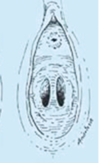Uterine/Vaginal/Hymen Anomalies Flashcards
What mullerian anomaly is most common among patients with recurrent pregnancy loss?
Septate Uterus
Miscarriage rate of 65%
What mullerian anomaly is most common overall?
Septate Uterus
Uterine anomalies are associated with what percent of recurrent pregnancy losses?
15%
What percentage of patients with mullerian anomalies will also have renal anomalies?
20-30%
When do mullerian (paramesonephric) ducts begin to elongate?
6 w gestation
What GA do mullerian ducts begin to fuse?
12 w gestation
What GA is the midline septum absorption complete?
20 w gestation
How do you differentiate MRKH Syndrome and Androgen IS?
AIS = 46XY karyotype, elevated testosterone
MRKH = 46XX Karyotype, with normal testosterone
Describe lateral fusion defects
your two arms don’t come together “elbows to hands” normally
Longitudinal vaginal/uterine septum, bicornuate, didelphys
Describe vertical fusion defects
TRANSVERSE vaginal septum, partial vaginal agenesis, and/or cervical agenesis
Failure of the canalization of the vaginal plate or failed Mullerian duct fusion
What congenital uterine anomaly is associated with the highest pregnancy risk?
Septate Uterus
A narrow angle between 2 endometrial cavities, ≤75º, and a fundal shape with notch ≤1 cm
Caused by failure of medial regression during fusion of the Müllerian ducts
Septate Uterus
A wide angle between 2 endometrial cavities, ≥105º, and a fundal shape with notch ≥1 cm
Incomplete fusion of the Müllerian ducts results in 2 distinct but communicating endometrial cavities
Bicornuate Uterus
well-defined elliptical-shaped uterus
HSG w/ banana-like uterine cavity
Hysteroscopy w/ single uterine cavity with deviation to one side and single tubal ostium
Unicornuate
Two separate divergent uterine horns with a deep fundal cleft between the 2 hemiuteri and a widened angle between 2 endometrial cavities
Didelphys








